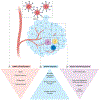Mechanisms of resistance to chimeric antigen receptor-T cells in haematological malignancies
- PMID: 37907724
- PMCID: PMC10965011
- DOI: 10.1038/s41573-023-00807-1
Mechanisms of resistance to chimeric antigen receptor-T cells in haematological malignancies
Abstract
Chimeric antigen receptor (CAR)-T cells have recently emerged as a powerful therapeutic approach for the treatment of patients with chemotherapy-refractory or relapsed blood cancers, including acute lymphoblastic leukaemia, diffuse large B cell lymphoma, follicular lymphoma, mantle cell lymphoma and multiple myeloma. Nevertheless, resistance to CAR-T cell therapies occurs in most patients. In this Review, we summarize the resistance mechanisms to CAR-T cell immunotherapy by analysing CAR-T cell dysfunction, intrinsic tumour resistance and the immunosuppressive tumour microenvironment. We discuss current research strategies to overcome multiple resistance mechanisms, including optimization of the CAR design, improvement of in vivo T cell function and persistence, modulation of the immunosuppressive tumour microenvironment and synergistic combination strategies.
© 2023. Springer Nature Limited.
Figures




References
-
-
Neelapu SS et al. Axicabtagene ciloleucel CAR T-cell therapy in refractory large B-cell lymphoma. N. Engl. J. Med 377, 2531–2544 (2017).
Together with Schuster et al. (2017), this seminal study validated the efficacy of anti-CD19 CAR-T cell therapy in patients with R/R lymphoma and showed a similar complete response rate (approximately 60%), despite differences in the CAR design and lymphodepletion regimens, setting a new standard of care for patients with R/R lymphomas.
-
-
-
Maude SL et al. Tisagenlecleucel in children and young adults with B-cell lymphoblastic leukemia. N. Engl. J. Med 378, 439–448 (2018).
This study shows the long-term remission rates achieved by tisa-cel (Kymriah, Novartis), a lentiviral-transduced second-generation CD19 CAR-T cell product containing a 4-1BB co-stimulatory domain. This product became the first FDA-approved gene therapy in 2017, when it received approval for paediatric and young adult patients with B-ALL.
-
-
- Abramson JS et al. Lisocabtagene maraleucel for patients with relapsed or refractory large B-cell lymphomas (TRANSCEND NHL 001): a multicentre seamless design study. Lancet 396, 839–852 (2020). - PubMed
Publication types
MeSH terms
Substances
Grants and funding
LinkOut - more resources
Full Text Sources
Medical

